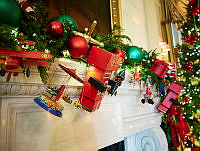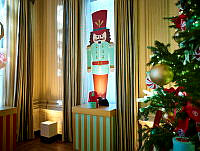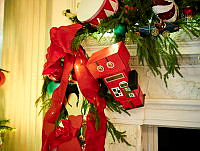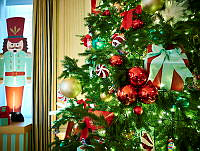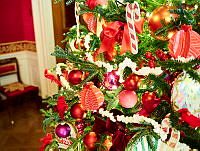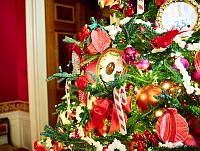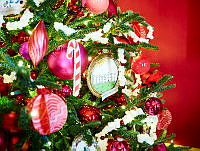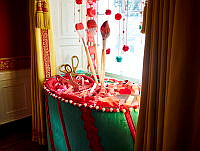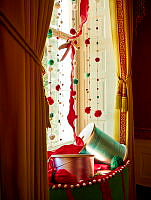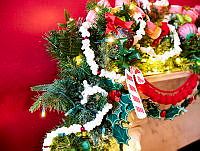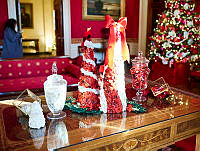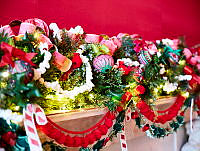The White House Album: The Theodore Roosevelt Years
Copyright © June 1997 White House Historical Association. All rights reserved under international copyright conventions. No part of this article may be reproduced or utilized in any form or by any means, electronic or mechanical, including photocopying, recording, or by any information storage and retrieval system, without permission in writing from the publisher. Requests for reprint permissions should be addressed to books@whha.org
It is hard to believe that nearly a hundred years have passed since Theodore Roosevelt became president of the United States. Recollections of him at the White House are vivid. And the White House was never quite the same after his seven years and 171 days there. He entered the presidency in 1901, but from the perspective of form and procedure, not to mention presidential tone, he brought so many changes that he seems to have ushered in the twentieth century. At least, he created the twentieth-century White House, which was to be different from the White House that was then already one hundred years old.
In 1898 Congress put President William McKinley in charge of the war with Spain, and as a result the American presidency, in the hands of the able and beloved McKinley, rose to a level of power not known since George Washington occupied the office. McKinley’s assassination in September 1901 threw the forty- two year old vice-president into office. A luminary of the war in Cuba and a man much in evidence in the press and in his own nearly continual flow of public speaking and published writing, such a showman as Roosevelt seemed unlikely for the presidency.

Archie Roosevelt, mounted on Algonquin on the western-style saddle he brought from Oyster Bay, was seven in 1901, and, like his brothers and sisters, attended public school in Washington.
Library of CongressHowever, his were to be legendary years. He and his second wife, Edith Carow Roosevelt, moved twelve blocks from their Washington row house to the White House with six children. They made the White House as much a family home as it has ever been. The president and his family went on hikes, collected pets of all sorts, and gave parties. And within a year, they saw the White House totally remodeled.
For it was Roosevelt’s destiny to dramatize the presidency McKinley had created. This he did, and he made the White House his stage, or, as everyone knows, his “bully pulpit.” He gave the decor an international flair, to suit the new tenor of life in Washington, which since 1893 had been a posting for full-rank ambassadors (as opposed to mere foreign ministers). To the formal setting he gave a common touch with humor and incongruous behavior, turning the simplest occasion into a theatrical production.

Ethel Roosevelt was ten in the fall of 1901, when she and the other children were photographed in the area of the south portico.
Isabella Hagner James Papers, The White HouseThe photographs here show the Roosevelt family and the White House. Most of the portraits were gifts from the various Roosevelts to Belle Hagner, Mrs. Roosevelt’s social secretary and the first to hold that position at the White House. The views of the house are from an album presented to the Roosevelts by the architect Charles McKim, who remodeled the house in the summer and fall of 1902.
Roosevelt and his family were people in the American mold of the time, assuming an almost ideal image as they represented their country. This presidency still casts a long shadow as we remember the bombastic president, who seemed to be everywhere, grinning and roaring, crisscrossing the nation by train, parading over half a thousand platforms, and embodying somehow the best of us.
Belle Hagner’s autographed portraits are in the Office of the Curator of the White House, a gift to the collection by Mrs. Alexander B. Hagner, while McKim’s pictures remain among the Roosevelts’ things at Sagamore Hill, the family’s home near Oyster Bay, New York, a property of the National Park Service.

Alice Roosevelt, the president’s daughter by his first marriage, moved to the White House at sixteen and within a few years was often featured in the glamor press. She mixed happily with New York’s “four hundred, ” whom her father, a Knickerbocker, considered insolent upstarts. Here she is seen, on the cover of the May I903 issue of Collier’s, in the renovated East Room, wearing the long court train that was standard attire for women at White House state functions before World War II.
Library of Congress
Above, the State Dining Room, as renovated by McKim for the Roosevelts, echoed the English Georgian country house style, paneled in oak, polished to perfection, and hung with tapestries, silver lighting devices, and hunting trophies. The latter were not bagged by the president but were bought from William Hart, a Manhattan decorator.
Library of Congress


















































